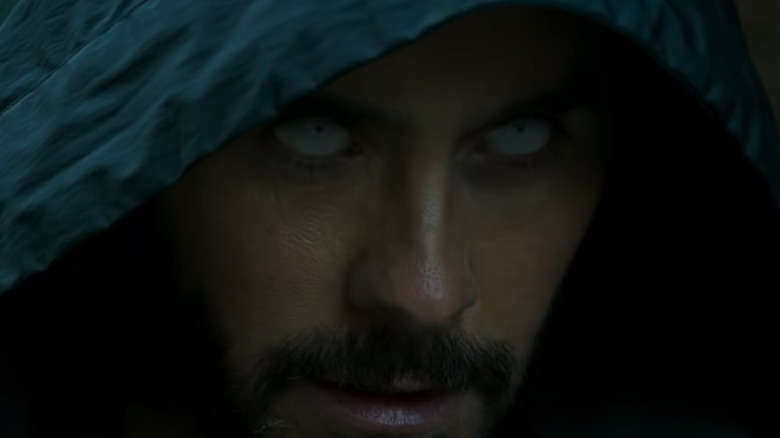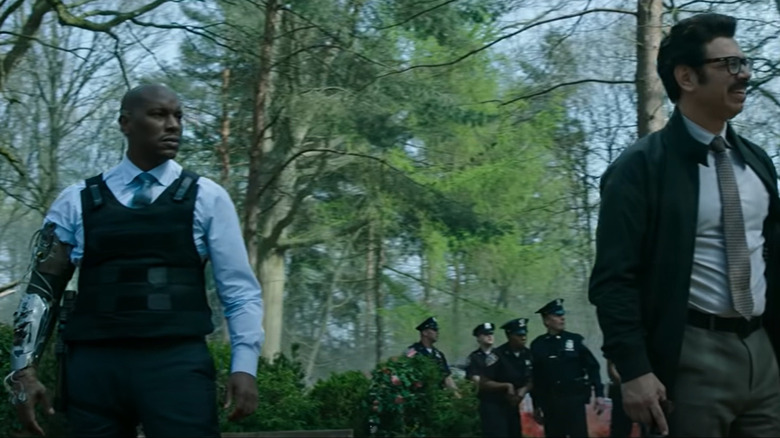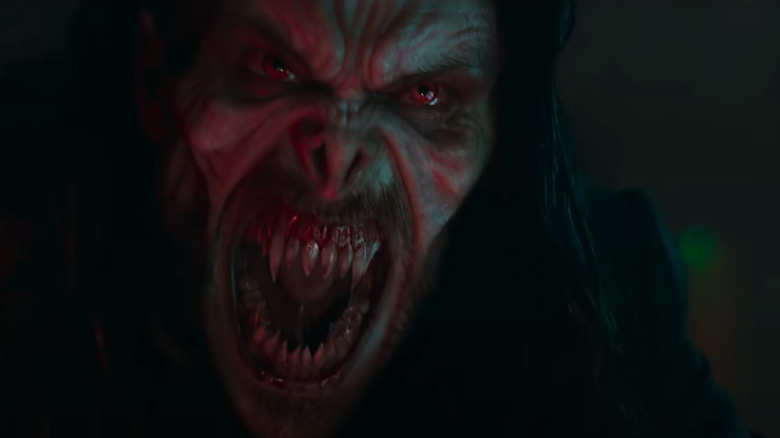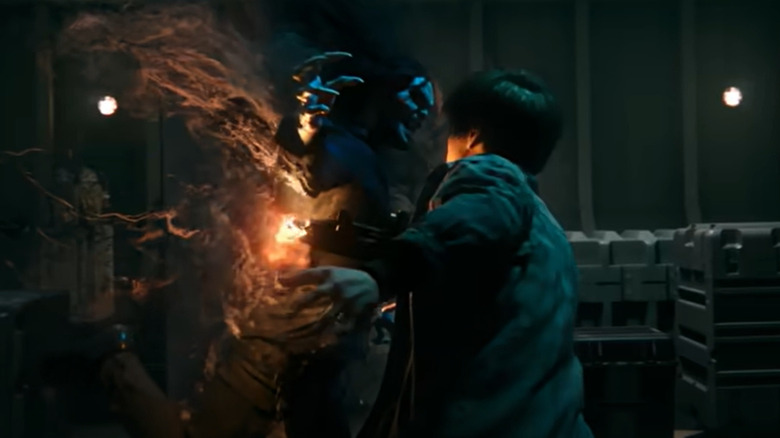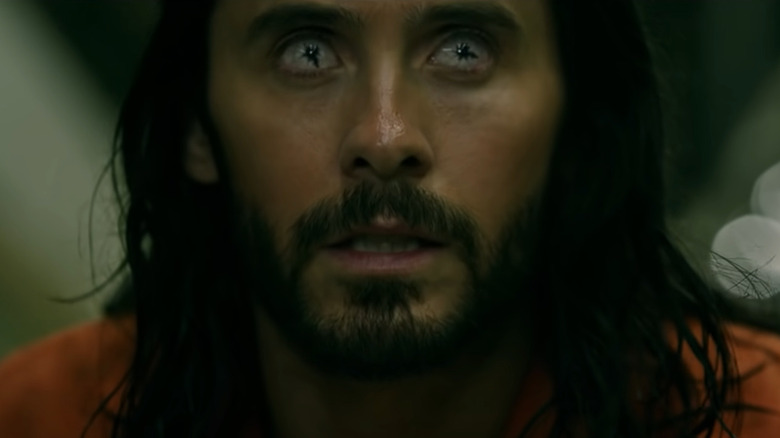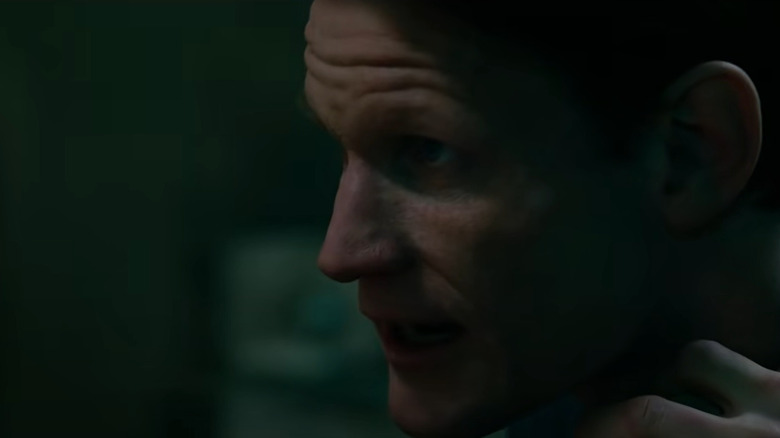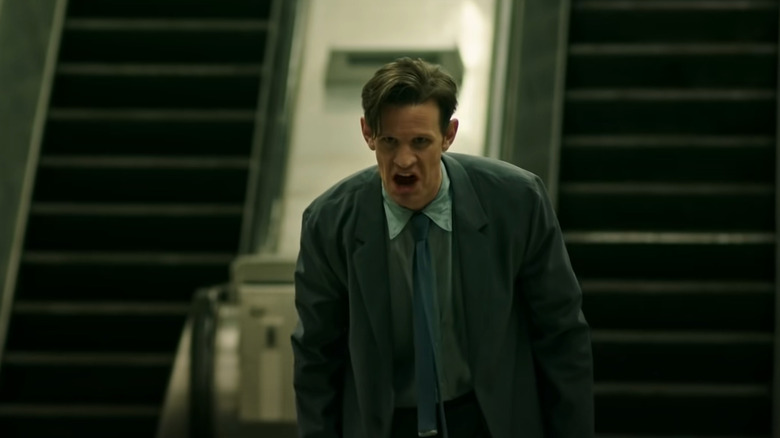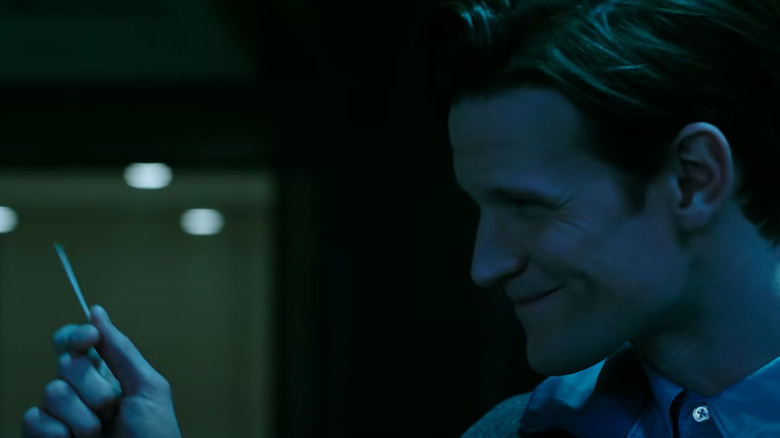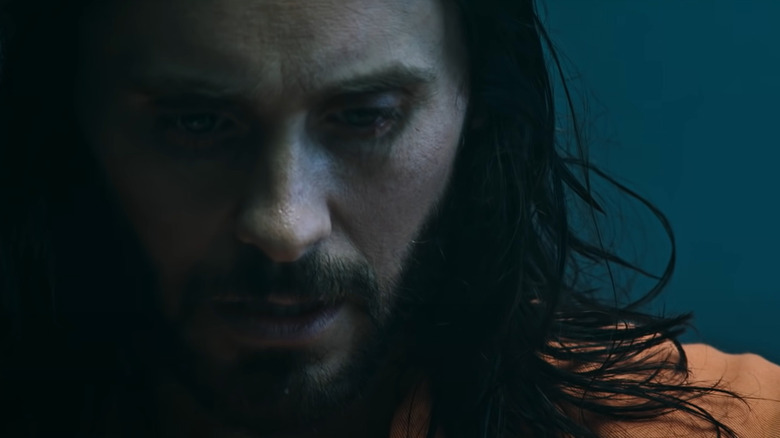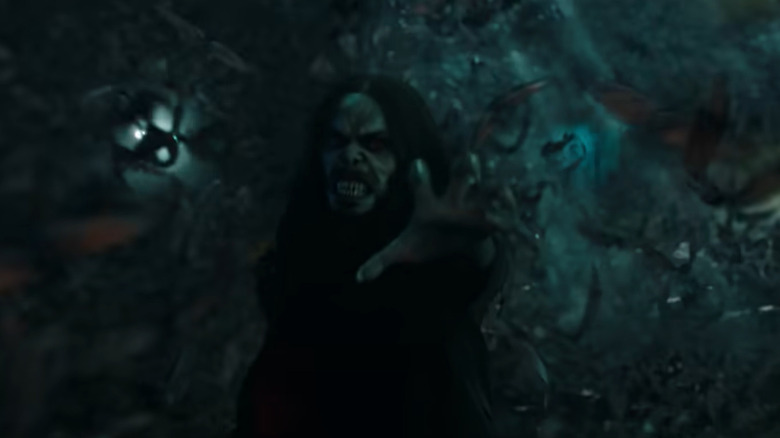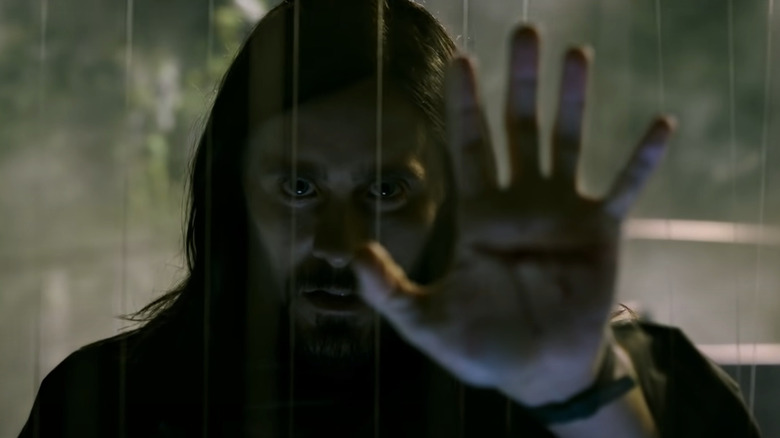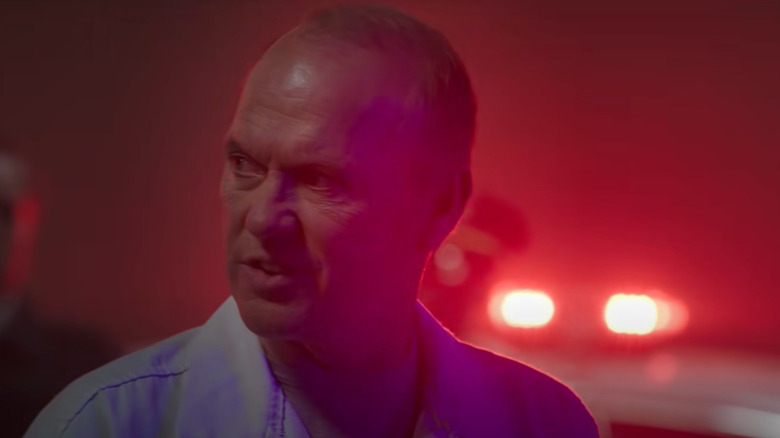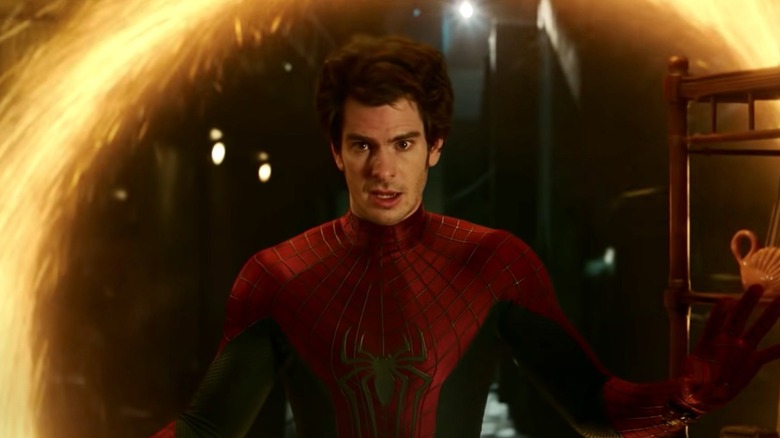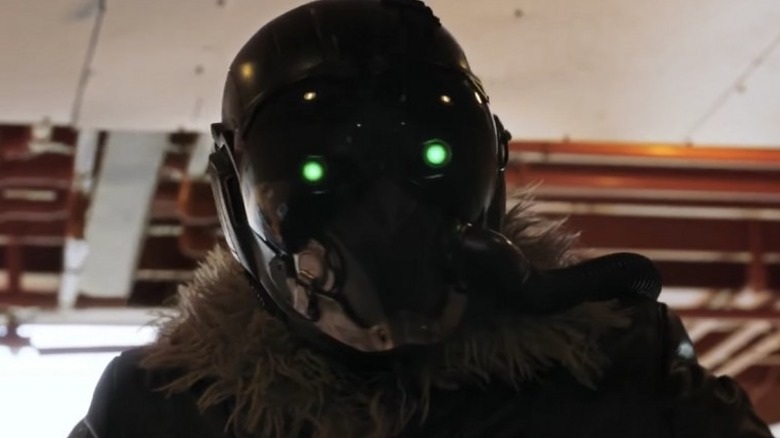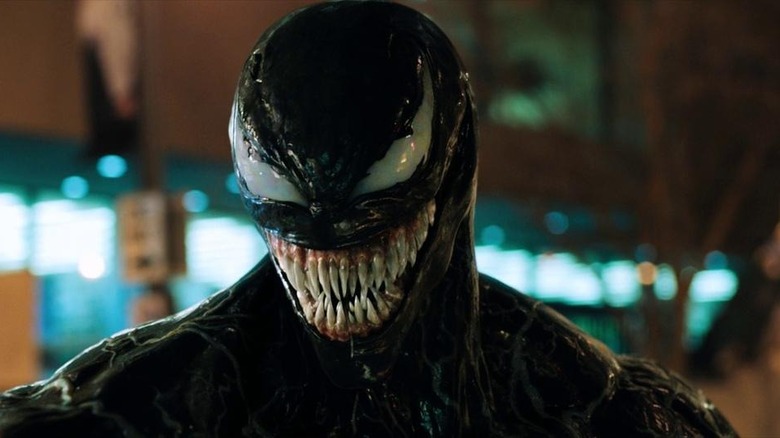Biggest Unanswered Questions From Morbius
Positioned as the third entry in Sony's Spider-Man Universe, Daniel Espinosa's "Morbius" stars Jared Leto as eponymous Marvel bloodsucker. Born with a rare and deadly blood disease, Michael Morbius takes it upon himself to find a cure, eventually synthesizing what he believes to be the answer by splicing the DNA of humans and vampire bats. His experiment proves to be a success, healing him of his physical ailments and imbuing him with incredible virility, but it also has a nasty side effect — an unquenchable thirst for human blood that causes Michael to transform into a violent vampire.
Unfortunately, "Morbius" isn't nearly as exciting as that pitch might make it sound. Critics have been brutal in their assessments of the film, lambasting its generic storyline, clumsy writing, messy pacing, and wooden characters. Though the "Venom" movies received their own doses of critical backlash, they at least remained entertaining thanks to some goofy writing and a great performance from Tom Hardy. It's sad to say, but it looks like Sony's Spider-Man Universe is getting worse, not better.
While it is flawed, "Morbius" does at least attempt to establish a significant amount of lore, both for the titular character himself and for the burgeoning franchise at large. There are a lot of questions left unanswered by the time the credits finish rolling — some caused by intentional mysteries, others the result of bad writing. Here are the biggest unanswered questions in "Morbius" and some theories as to their possible answers. There will be major spoilers ahead.
What happened to all those scenes from the Morbius trailers?
One thing audiences may quickly realize after watching "Morbius" is that it lacks a number of moments that were shown prominently in the film's trailers. In the trailer, Morbius makes a joke after calling himself Venom. In the movie, he simply growls and intimidates his quarry into running away. In the trailer, Michael Keaton's Adrian Toomes character — a transplant from "Spider-Man: Homecoming" — speaks directly to Morbius, telling him that they should stay in touch. This moment never takes place in the film, and the two characters' eventual meeting takes place with no explanation as to how they were put in contact with one another.
There are a number of other such exclusions tied to side characters like FBI agent Simon Stroud (Tyrese Gibson) and Nicholas (Jared Harris), Michael's father figure. Trailers are only a few minutes each, so it's curious to see so many moments that were used to advertise the film be cut from the theatrical version. It's unclear why so many changes were made, and given the lackluster response "Morbius" has received, it's hard not to wonder if it could have been improved by suffering a few less cuts. After all, at only 1 hour and 44 minutes, the film is pretty short.
How does Morbius fly?
As explained in the "Morbius" movie, Michael gets his powers from the vampire bat DNA he injects into his body. The ensuing transformation causes him to thirst for blood, but it also grants him superhuman strength and speed, acrobatic agility, incredible hearing and echolocation, and the ability to fly. Morbius also moves with a smoky motion blur effect when he's in his vampire state, and it's never fully explained if that's part of his powers or just a visual manifestation of how quickly he moves.
Here's the problem: In the Marvel comics, there are actual vampires. There is supernatural precedent for powers like flight, which makes Morbius' own abilities a bit more plausible. In the movie, however, there is no such precedent. Morbius synthesizes his injection solely from normal DNA and an unnamed chemical cocktail. Because of the sci-fi elements at play, most of his powers feel believable enough, but when he starts flying, things get a bit more confusing. Yes, bats can fly, but they also have wings. In the movie, Morbius simply feels the air currents around him and ... levitates. Is he propelling himself using his sonar somehow? Is there another force at play? "Morbius" never offers an explanation, and maybe that's for the best.
How does Morbius get back to New York from the boat?
Because his DNA experiments are highly illegal, Morbius hires a ship and a crew of mercenaries to take him into international waters for the final test. After injecting himself and becoming a vampire, he kills the whole crew, save for his partner Martine (Adria Arjona). Eventually, Morbius comes to his senses again, prompting him to send out a distress call and then quickly jump overboard.
Oddly, the film never explains how he manages to swim the 13 nautical miles back to Long Island. Morbius' vampire powers provide him with excellent strength, speed, and stamina, but even with those boosts, that's a long way to go. Morbius doesn't learn how to fly until much later, so he definitely swims back to the mainland. Given his enhancements, it's certainly not out of the question that he could have gotten home safe and sound, but it's telling that the film opts not to address his actual journey back. Bats aren't exactly the world's best swimmers, after all.
How does artificial blood work on Morbius?
Because drinking human blood obviously isn't ideal, Morbius relies on artificial blood to satiate his vampiric urges. However, he quickly discovers that the substitute has a waning effectiveness. The same dosage that kept him controlled for six hours the first time starts working for shorter and shorter spans of time, with Morbius claiming that artificial blood will eventually stop calming him altogether.
The reason for this diminishing potency is never properly explained. Presumably, it works similarly to a drug tolerance, with Morbius' body slowly getting used to the effects of the artificial blood and therefore requiring more to produce the same effect. Still, that doesn't explain why it would eventually become completely useless. "Morbius" also never explains why Leto's vampire craves human blood specifically. He makes a point of saying that it's human blood the beast within him wants, but ... why? Why not animal blood? Vampire bats feed on many different animals, after all, so wouldn't Morbius be the same after his transformation? The film never answers these questions, and by the end of the movie, it's tough to tell exactly where Morbius' cravings stand.
What's Milo's story in Morbius?
One of the most important characters in "Morbius" is Milo, played by Matt Smith as an adult and by Joseph Esson as a child. Milo suffers from the same blood disease as Michael, and they became close friends as kids after meeting at a treatment facility. After taking the same injection that turned Morbius into a vampire, Milo turns to the dark side and starts killing humans for sport.
For a character who's so central to the overall story of "Morbius," Milo is woefully underdeveloped. As an adult, he funds the majority of Michael's experiments, suggesting that he comes from a rich background. However, Milo's history is barely touched on at all, other than the time he spent hospitalized as a boy. There's a reference to him dropping out of law school, but other than that, there are basically no clues to Milo's past. The film never really even explains why he willingly goes by Milo — a relatively morbid nickname given to him by Morbius when they were kids and not in fact his real name, which is Lucien. All told, the character feels more like a plot device than a person, and when he starts acting like a deranged murderer later in the movie, it's hard to understand why.
Why does Milo become so evil in Morbius?
Milo's mysterious backstory is a little bit baffling, but it's not the most perplexing thing about the character. Far more jarring is his instant transition from being mildly misanthropic to full-on homicidal, which takes place almost immediately after his transformation into a vampire. "Morbius" would like viewers to believe that its titular antihero is a pretty smart guy — smart enough to win a Nobel prize. So when Morbius says that Milo is his best friend, and that he trusts him, it seems safe to assume that those are fair assessments.
That makes it all the more baffling when Milo turns into a crazed murderer. At one point, he says that other people deserve to feel the way he's always felt — like death is hanging over them. This line suggests his violence is a result of anger built up over the course of his life. Surely, Milo is justified in feeling a level of frustration with the genetic hand he was dealt, and even with the world's callous treatment of disabled people. But that still doesn't really explain how his morals get so warped so quickly. In other scenes, Milo celebrates his mutation simply because of the strength it gives him, and he implies that he feels no guilt killing regular humans because they're beneath him now. So which is it? Is he upset at a world that abandoned him? Or does he suddenly believe human life is worthless? Either way, his villainous turn feels incredibly rushed.
What's Milo's actual plan?
Another question left unanswered about Milo is what his actual plan is after he becomes evil. He kills an innocent nurse because he isn't in control of his powers yet, then he encourages Morbius to go on a killing spree with him. When his friend refuses, Milo starts wantonly murdering people, all the while taunting Morbius and trying to get him to fight. After Morbius escapes, Milo ... goes to a bar? And beats up some toxic dude-bros? And then he decides to ruin Michael's entire life by killing his romantic partner and their surrogate father.
Sometimes, it seems like Milo is only interested in feeding and enjoying his powers. Others times, he appears fiercely devoted to ruining Michael's life — a man who has never shown him anything but kindness. He doesn't even know Morbius plans to kill him until the final fight, but he still goads him anyway. And to top it all off, after Morbius sticks him with the lethal injection, Milo appears apologetic for his behavior.
Matt Smith is a capable actor. He can play goofy roles, like in "Doctor Who," and he can play serious roles, like in "The Crown." But even an actor with that level of talent and versatility can't make sense of Milo's motivations.
Is Morbius a good guy or a bad guy?
For most of "Morbius," it's tough to tell if the titular character is a hero or a villain, which is largely the point. At heart, Morbius is an antihero, and he oscillates wildly between the dark and the light throughout the film. In his very first scene as a vampire, he slaughters a whole crew full of people. The film tries to whitewash this killing spree a bit by painting the victims as immoral mercenaries, but that doesn't really absolve Morbius of guilt. After all, he's the one who loses control on their boat, and they only start attacking him after he comes for them.
Morbius doesn't kill any innocents on screen from that point onward, but his moral status remains in flux. His selfless desires to heal people and make the world a better place are constantly at odds with his own survival instincts. While he keeps the balance pretty well for most of the film, he's far from a flawless hero.
Where do all the bats come from at the end of Morbius?
One of the more bizarre abilities Michael shows off in "Morbius" is the power to communicate with bats and even command them to do his will. He uses this skill in his climactic battle against Milo, sending out a massive sonar wave to summon an army of bats to his location. Once there, they help the doctor to his feet, and he sends them into battle against his old friend-turned-foe.
The ability to summon and control bats is strange in its own right, but given everything else Morbius does in the movie, it feels pretty par for the course. Where all those bats came from, however, is another matter entirely. Michael and Milo dive pretty deep beneath the streets of New York City during their fight, meaning that Morbius' call goes out through a series of old subway tunnels. It's technically not impossible for that many bats to be hiding out in such close proximity under the city, but it still seems a little far-fetched. Perhaps there's some other reason for the creatures' presence — some supernatural connection to Morbius that manifested before the battle even took place. Or maybe it's just a plot hole. The world may never know.
Why does Morbius let himself live?
Before his confrontation with Milo, Morbius tells Martine that artificial blood will soon be useless on him, implying that he'd rather end his own life than be turned completely into a monster. He administers one dose of the lethal injection he creates to Milo, killing his old friend after a heated battle. However, the post-credits scenes reveal that Morbius is still alive and well after the events of the film. If his calculations were correct, he would have been long past the point of using artificial blood by then, and yet he's still allowing himself to live. Why?
Maybe his triumph over Milo convinces Morbius to embrace his powers. Maybe he finds an extra level of control after dwelling in his vampiric form for a while. Or maybe his survival instinct just kicks in, and he starts slipping into a less morally defensible pattern of behavior. The movie never actually shows Michael feeding on innocent humans after the boat incident, but his interest in teaming up with the Vulture suggests he might be turning into the "Spider-Man" villain that fans know and love.
How does Adrian Toomes appear in Morbius?
In the first post-credits scene in "Morbius," Michael Keaton's Adrian Toomes character, aka the Vulture, is teleported from the MCU to Sony's Spider-Man Universe. Presumably, this is a side-effect of the multiverse spell cast by Doctor Strange in "Spider-Man: No Way Home." However, even by that logic (which is, to be clear, magic), Toomes' appearance doesn't quite seem to make sense.
In "No Way Home," Strange's spell brings everyone in every reality who knows that Peter Parker is Spider-Man to the core MCU timeline. When the spell is broken, all those visitors return to their home dimensions. Because Toomes was part of the core MCU timeline to start, it doesn't really make sense for him to appear to be teleported away.
Again, because we're talking about a magical spell, anything is possible. Maybe there were some unanticipated aftershocks. Maybe there's something about Toomes in particular that causes him to switch realities. Or maybe, just maybe, nobody at Sony actually understands how any of these plot devices actually work.
Who is Spider-Man in the Morbius universe?
After joining Morbius' universe in the first post-credits scene, Adrian Toomes actually meets the vampire in the second. The sequence shows Michael driving to a location in the middle of nowhere, clearly with a meeting in mind. When he arrives, he's quickly approached by Toomes, who's fully decked out in a shiny new version of his Vulture suit. In their brief exchange, Toomes says that he believes his trip across the multiverse had "something to do with Spider-Man" — a comment that Morbius takes completely in stride. That suggests that the vampire is already familiar with Marvel's famous wall-crawler. If so, then who's the Spider-Man of Sony's Spider-Man Universe?
One theory making the rounds is that "Morbius" and the "Venom" movies actually take place in the same reality as Andrew Garfield's "Amazing Spider-Man" films. It's clearly not Tobey Maguire's universe. because he has a canonically different Venom, but Garfield is a definite possibility — especially given how highly praised his performance in "No Way Home" was. Of course, Sony could just as easily give their franchise a new Spider-Man. As of yet, though, there's no official proof that Peter Parker in particular even exists in the "Venom" universe. Fans will have to wait and see.
How does Adrian Toomes get the Vulture suit in Morbius?
One of the big questions surrounding Toomes' "Morbius" return is how he manages to find such a similar Vulture suit in a universe where the Chitauri never attacked Earth. In "Spider-Man: Homecoming," the Vulture suit was built from Chitauri technology salvaged after the first "Avengers" movie. While Toomes' gear is clearly a bit different in "Morbius," he'd still need some equally impressive resources to put it all together in such a short timeframe.
Going off of the theory that "Morbius" takes place in the "Amazing Spider-Man" universe, it's possible that the new Vulture getup is courtesy of Oscorp. A robotic set of Vulture wings are briefly shown at the end of "The Amazing Spider-Man 2" as part of the film's Sinister Six tease. Because a third film was never produced, nothing ever came of that Easter egg. But now that Vulture is back in a non-MCU timeline, it could all be coming together.
Are the Sinister Six finally coming after Morbius?
During his meeting with Morbius, Vulture suggests that they and a group of unnamed others all team up, prompting a positive response from the vampire. Director Daniel Espinosa teased a Sinister Six setup before the film was even released, suggesting that's been Sony's plan for some time (per CinemaBlend). Rumors of a Sinister Six movie have circulated for years, even before Tom Holland took up the mantle of Peter Parker. Could they finally be coming true?
Between Vulture, Morbius, and Venom, that's already three established characters — half of the necessary team. And with a "Kraven the Hunter" movie already on the way, there's a pretty obvious fourth. Who else could Sony throw in to complete the Sinister Six? Most of the big "Spider-Man" villains have been brought to live action already — characters like Mysterio, Green Goblin, Sandman, Electro, and Doctor Octopus — but that doesn't mean they couldn't come back. Or maybe we'll get some comic book baddies who haven't made as much of a splash on the big screen yet — Shocker, Scorpion, and Hobgoblin all come to mind. Regardless of what direction Sony ultimately takes, there's a lot of potential for a proper Sinister Six team-up in the near future. And if we're lucky, it'll be a whole lot better than "Morbius."
